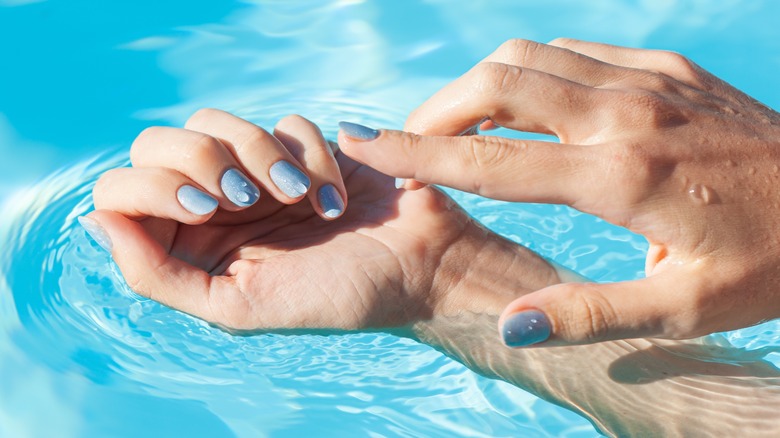How To Keep Your Nails Healthy After Swimming In A Chlorinated Pool
For many people, warm weather means one thing: pool season. Your one-stop shop for fun in the sun, the nearest swimming pool may be calling your name for regular summertime dips. But before you slip into that bikini and go for a dive, there are a few considerations to address. Proper SPF is a must-have, of course, and you may need to cover up any freshly dyed hair or new tattoos. But for the sake of your nails, don't forget about the necessary evil that is chlorine.
You may already know that chlorine — a popular pool disinfectant — can do a number on your skin and hair by robbing it of moisture. As dermatologist Shereene Idriss, M.D., tells Elle, chlorine "strips our skin and hair of their natural oils, and leaves us looking dry and lackluster." You may even need to take steps to protect your hair from pool water.
However, did you also know that your nails can also take damage from chlorinated swimming pools? The harsh chlorine — and even prolonged exposure to just plain old water — can have a similarly drying effect on your mani-pedi. Of course, that doesn't mean you have to skip all those summer pool parties. Chlorine-related damage can be tended to with simple moisturizing products. But to prevent that damage without sacrificing your swim time, it's all about understanding how chlorine affects your nails, and then using protective countermeasures like high-performance base and top coats.
Chlorinated water can weaken the fundamental structure of your nails
We all love a plunge in the pool, but chlorinated water can present a harmful one-two punch to the structural integrity of your nails. First, there's the water damage. As dermatology professor and nail expert Dana Stern, M.D., explains to Well+Good, your nails are more absorbent than they look — "1,000 times more absorptive of water than the skin" even. The cells in your fingernails and toenails suck up H2O, causing those cells to expand. Then, as your nails dry, the cells contract back to their normal size. This expansion and contraction puts stress on the strength and structure of the nail, contributing to thinning, softening, peeling, and breakage. Think about the way your skin prunes up after too long in a bath. Now imagine the same process affecting your nails, which have no elasticity to bounce back. Of course they're going to be weaker in the aftermath.
Adding chlorine to the equation only worsens matters. Just like this chemical dries out your hair and skin, it can leach hydration from your cuticles. "Chlorinated water can induce similar nail changes as plain water, but it's often even more harsh because chlorine can also strip your nails of the natural oils that keep the cuticles hydrated," dermatologist Rachel Nazarian tells The Zoe Report. Alas, parched cuticles can negatively impact nail growth. Long story short? Protecting your nails and cuticles from chlorinated pool water is critical for their durability, sheen, and overall health, and can be just as important as restoring moisture after your swim.
A hydrating base coat and protective top coat can help safeguard your nails
Level up your post-swim routine with some cuticle care tips for healthier nails. Because that chlorinated pool water dries out your cuticles, it's critical to reintroduce some moisture. Hydrating hand creams are a good start, but specialized cuticle oils are even better. In fact, you may want to embrace this self-care step even when you haven't been swimming, as applying cuticle oil every day has a host of benefits — from strengthening nails and preventing infection to encouraging growth.
Whether you're worried about regular water damage, drying chlorine, or both, the most straightforward solution is to prevent damage in the first place by limiting its contact with your nails. But there's a big difference between sliding on gloves while washing dishes and trying to wear gloves in a chlorinated pool. Instead, consider creating a physical barrier with the strategic use of nail polish.
Applying a hydrating base coat isn't just helpful before a manicure — it can also create a protective layer that's handy against water damage, sealing your nail bed to reduce absorbency and defend against pesky peeling. Bonus points if you choose a nutrient-rich base that infuses your nail with a little extra TLC. Whether or not you then apply a colored polish, consider finishing the manicure with a strong top coat to further minimize exposure to irritants like water, chlorine, or even salt (we're looking at you, ocean swimmers).


